An Enhanced Precoder for Multi User Multiple-Input Multiple-Output Downlink Systems
Abstract
1. Introduction
2. Multi User MIMO Downlink System Model
3. Conventional Precoding Schemes
3.1. Conventional BD Precoder
3.2. RBD Precoder
3.3. GBD Precoder
4. MGBD Scheme and Adaptive MGBD Scheme
4.1. Modified GBD Precoder
4.1.1. Case 1
4.1.2. Case 2
4.2. Adaptive MGBD Precoder
5. Simulation Results
5.1. MGBD Precoder
5.2. Adaptive MGBD Precoder
5.3. Computational Complexity Analysis
6. Conclusions
Author Contributions
Funding
Conflicts of Interest
Appendix A. Derivation of FMU
References
- Dahlman, E.; Parkvall, S.; Skold, J. 4G, LTE-Advanced Pro and the Road to 5G; Academic Press: Cambridge, MA, USA, 2016. [Google Scholar]
- Heath, R.W.; Airy, M.; Paulraj, A.J. Multiuser diversity for MIMO wireless systems with linear receivers. In Proceedings of the Conference Record of Thirty-Fifth Asilomar Conference on Signals, Systems and Computers (Cat.No.01CH37256), Pacific Grove, CA, USA, 4–7 November 2001; pp. 1194–1199. [Google Scholar]
- Pan, Z.G.; Wong, K.K.; Ng, T.S. MIMO antenna system for multi-user multi-stream orthogonal space division multiplexing. In Proceedings of the IEEE International Conference on Communications, ICC ’03, Anchorage, AK, USA, 11–15 May 2003; pp. 3220–3224. [Google Scholar]
- Vishwanath, S.; Jindal, N.; Goldsmith, A. On the capacity of multiple input multiple output broadcast channels. In Proceedings of the IEEE International Conference on Communications, ICC 2002 (Cat. No.02CH37333), New York, NY, USA, 28 April–2 May 2002; pp. 1444–1450. [Google Scholar]
- Spencer, Q.H.; Peel, C.B.; Swindlehurst, A.L.; Haardt, M. An introduction to the multi-user MIMO downlink. IEEE Commun. Mag. 2004, 42, 60–67. [Google Scholar] [CrossRef]
- Sampath, H.; Talwar, S.; Tellado, J.; Erceg, V.; Paulraj, A. A fourth-generation MIMO-OFDM broadband wireless system: Design, performance, and field trial results. IEEE Commun. Mag. 2002, 40, 143–149. [Google Scholar] [CrossRef]
- Castillo-Soria, F.R.; Sánchez-García, J.; Maciel-Barboza, M.; Flores-Troncoso, J. Multiuser MIMO downlink transmission using block diagonalization and generalized spatial modulation techniques. AEU-Int. J. Electron. Commun. 2016, 70, 1228–1234. [Google Scholar] [CrossRef]
- Vishwanath, S.; Jindal, N.; Goldsmith, A. Duality, achievable rates, and sum-rate capacity of Gaussian MIMO broadcast channels. IEEE Trans. Inf. Theory 2003, 49, 2658–2668. [Google Scholar] [CrossRef]
- Viswanath, P.; Tse, D.N.C. Sum capacity of the vector Gaussian broadcast channel and uplink-downlink duality. IEEE Trans. Inf. Theory 2003, 49, 1912–1921. [Google Scholar] [CrossRef]
- Swales, S.C.; Beach, M.A.; Edwards, D.J.; McGeehan, J.P. The performance enhancement of multibeam adaptive base-station antennas for cellular land mobile radio systems. IEEE Trans. Veh. Technol. 1990, 39, 56–67. [Google Scholar] [CrossRef]
- Costa, M. Writing on dirty paper (corresp.). IEEE Trans. Inf. Theory 1983, 10, 439–441. [Google Scholar] [CrossRef]
- Ginis, G.; Cioffi, J.M. A multi-user precoding scheme achieving crosstalk cancellation with application to DSL systems. In Proceedings of the Conference Record of the Thirty-Fourth Asilomar Conference on Signals, Systems and Computers (Cat. No.00CH37154), Pacific Grove, CA, USA, 29 October–1 November 2000; pp. 1627–1631. [Google Scholar]
- Windpassinger, C.; Fischer, R.F.; Vencel, T.; Huber, J.B. Precoding in multiantenna and multiuser communications. IEEE Trans. Wirel. Commun. 2004, 3, 1305–1316. [Google Scholar] [CrossRef]
- Spencer, Q.H.; Swindlehurst, A.L.; Haardt, M. Zero-forcing methods for downlink spatial multiplexing in multiuser MIMO channels. IEEE Trans. Signal Process. 2004, 52, 461–471. [Google Scholar] [CrossRef]
- Khai, L.D. Low-Complexity Block Diagonalization Precoder Hardware Implementation for MU-MIMO 4 × 4. J. Inf. Commun. Converg. Eng. 2019, 17, 1–7. [Google Scholar]
- Stankovic, V.; Haardt, M. Generalized design of multi-user MIMO precoding matrices. IEEE Trans. Wirel. Commun. 2008, 7, 953–961. [Google Scholar] [CrossRef]
- Sada, T.; Webber, J.; Nishimura, T.; Ohgane, T.; Ogawa, Y. A generalized approach to block diagonalization for multiuser MIMO downlink. In Proceedings of the 1st Annual IEEE International Symposium on Personal, Indoor and Mobile Radio Communications, Instanbul, Turkey, 26–30 September 2010; pp. 504–509. [Google Scholar]
- Flores, A.R.; de Lamare, R.C.; Clerckx, B. Linear Precoding and Stream Combining for Rate Splitting in Multiuser MIMO Systems. IEEE Commun. Lett. 2020, 24, 890–894. [Google Scholar] [CrossRef]
- Ha, J.G.; Ro, J.H.; Song, H.K. Throughput Enhancement in Downlink MU-MIMO Using Multiple Dimensions. Electronics 2019, 8, 758. [Google Scholar] [CrossRef]
- Scaglione, A.; Stoica, P.; Barbarossa, S.; Giannakis, G.B.; Sampath, H. Optimal designs for space-time linear precoders and decoders. IEEE Trans. Signal Process. 2002, 50, 1051–1064. [Google Scholar] [CrossRef]
- Nishimoto, H.; Kato, S.; Ogawa, Y.; Ohgane, T.; Nishimura, T. Imperfect block diagonalization for multiuser MIMO downlink. In Proceedings of the 2008 IEEE 19th International Symposium on Personal, Indoor and Mobile Radio Communications, Cannes, France, 15–18 September 2008. [Google Scholar]
- Chae, C.B.; Forenza, A.; Heath, R.W.; McKay, M.R. Adaptive MIMO transmission techniques for broadband wireless communication systems [Topics in Wireless Communications]. IEEE Commun. Mag. 2010, 48, 112–118. [Google Scholar] [CrossRef]
- Chen, X.; Huang, M.; Zhao, M.; Zhou, S.; Wang, J. Analysis and Design of Tomlinson-Harashima Precoding for Multiuser MIMO Systems. In MIMO Systems, Theory and Applications; Bizaki, H.K., Ed.; IntechOpen: London, UK, 2011; pp. 237–264. [Google Scholar]
- Zu, K.; De Lamare, R.C. Low-complexity lattice reduction-aided regularized block diagonalization for MU-MIMO systems. IEEE Commun. Lett. 2012, 16, 925–928. [Google Scholar] [CrossRef]
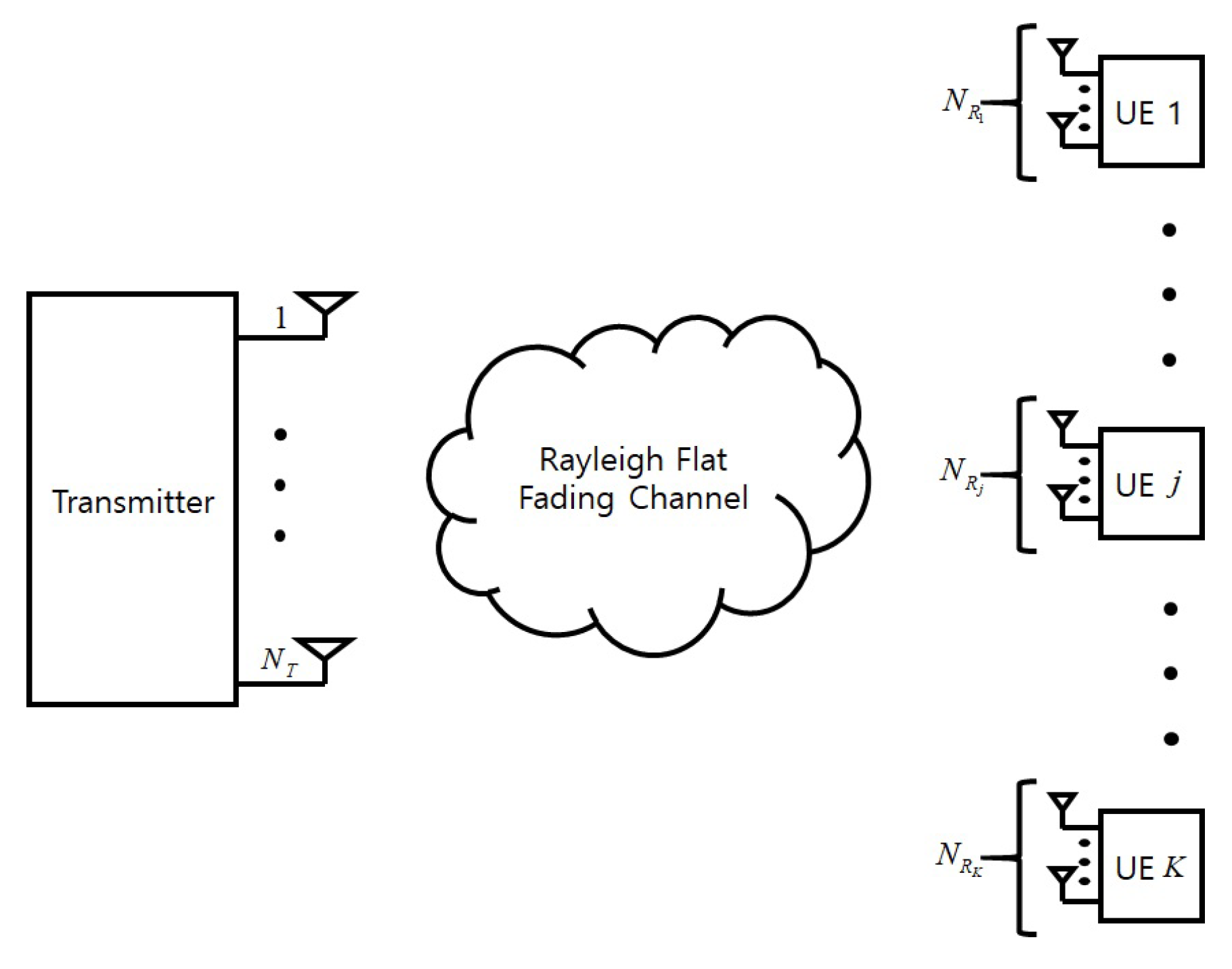
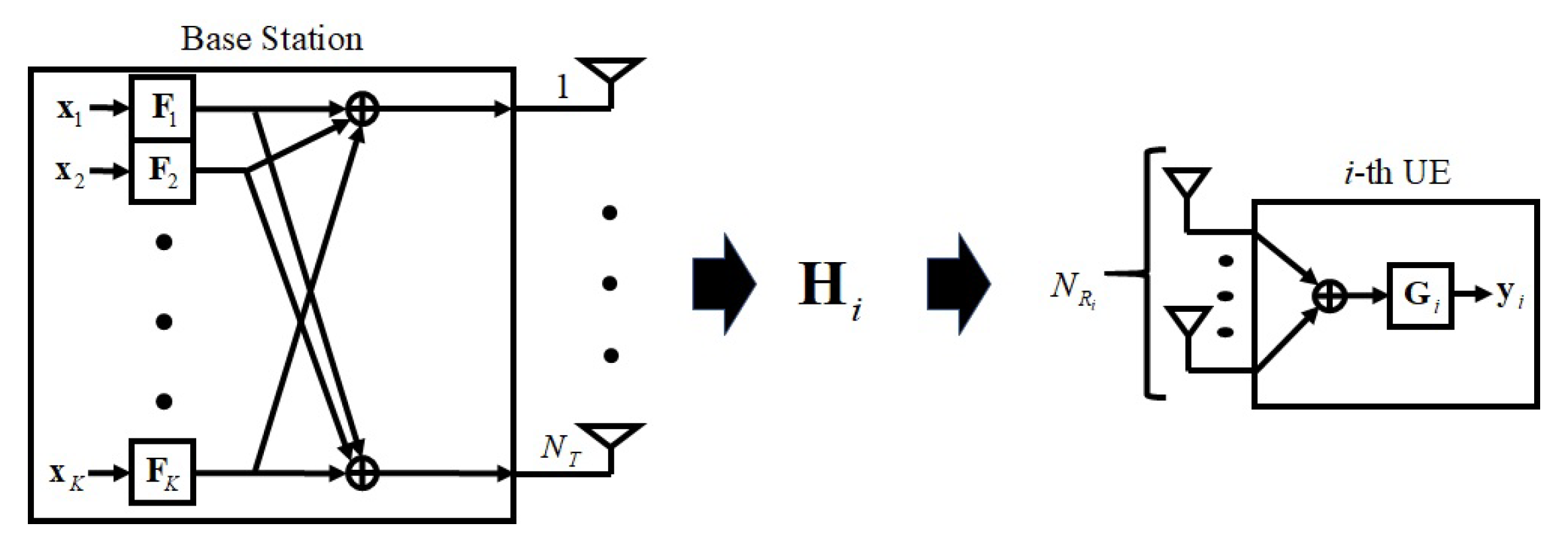
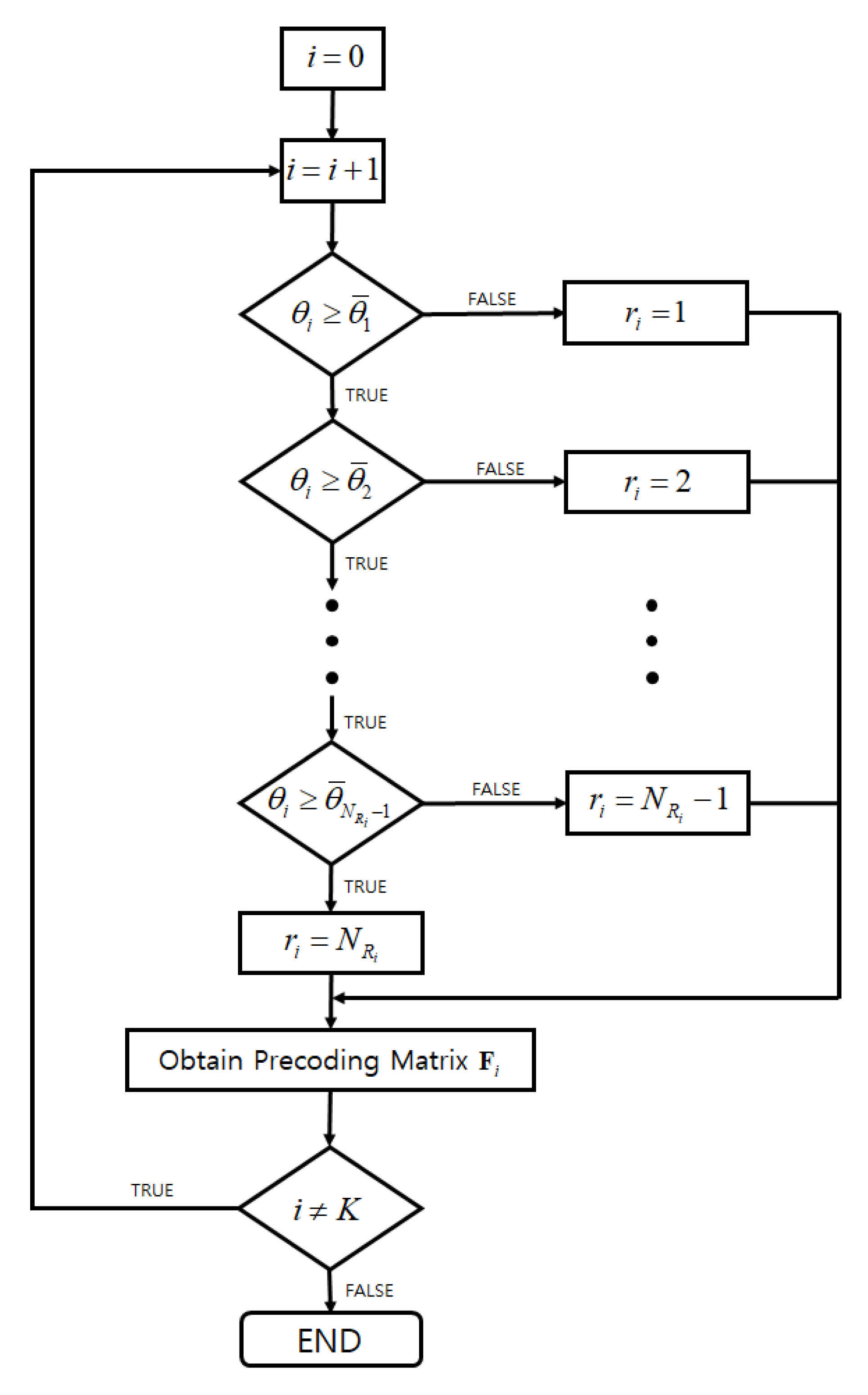
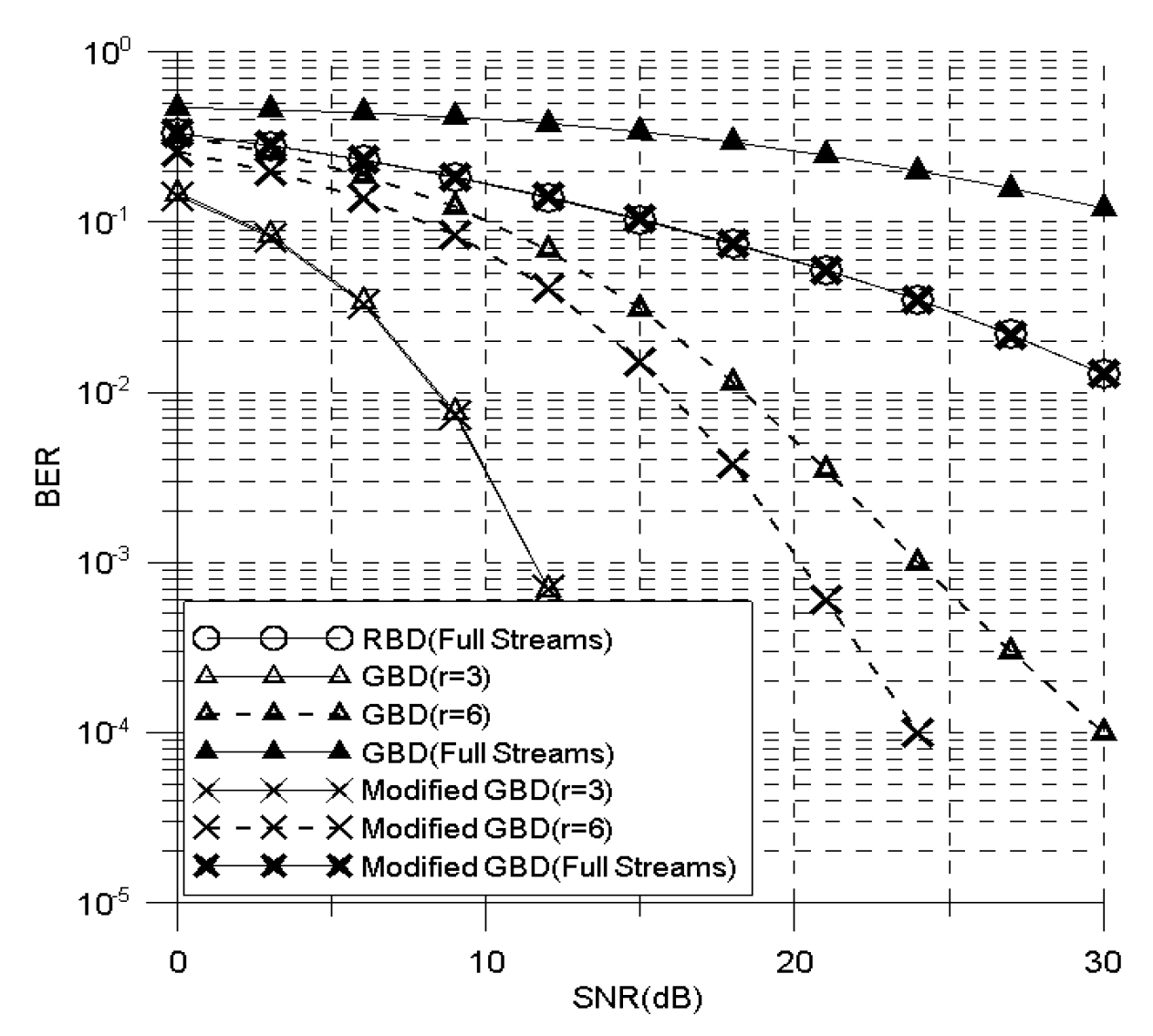


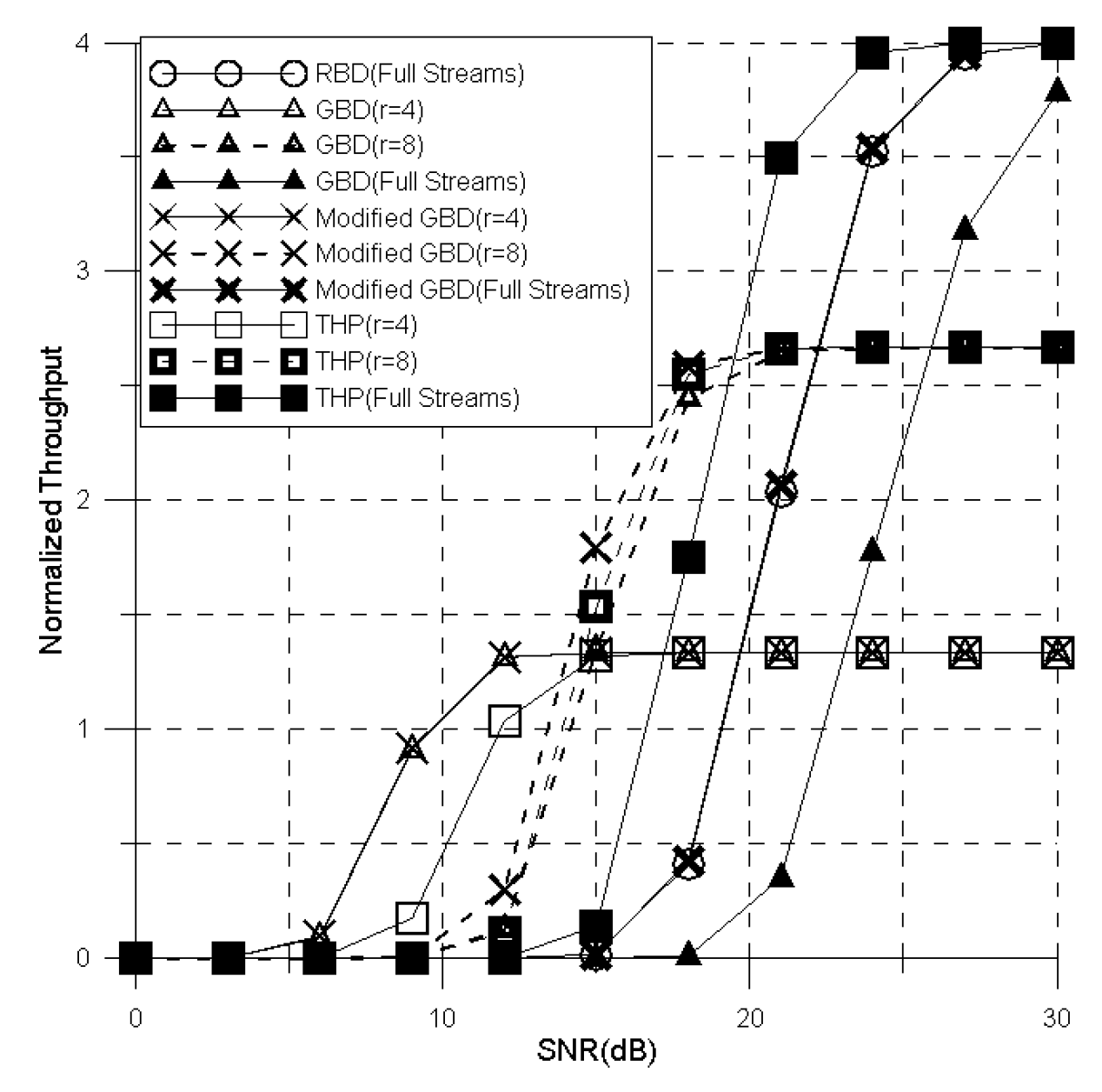
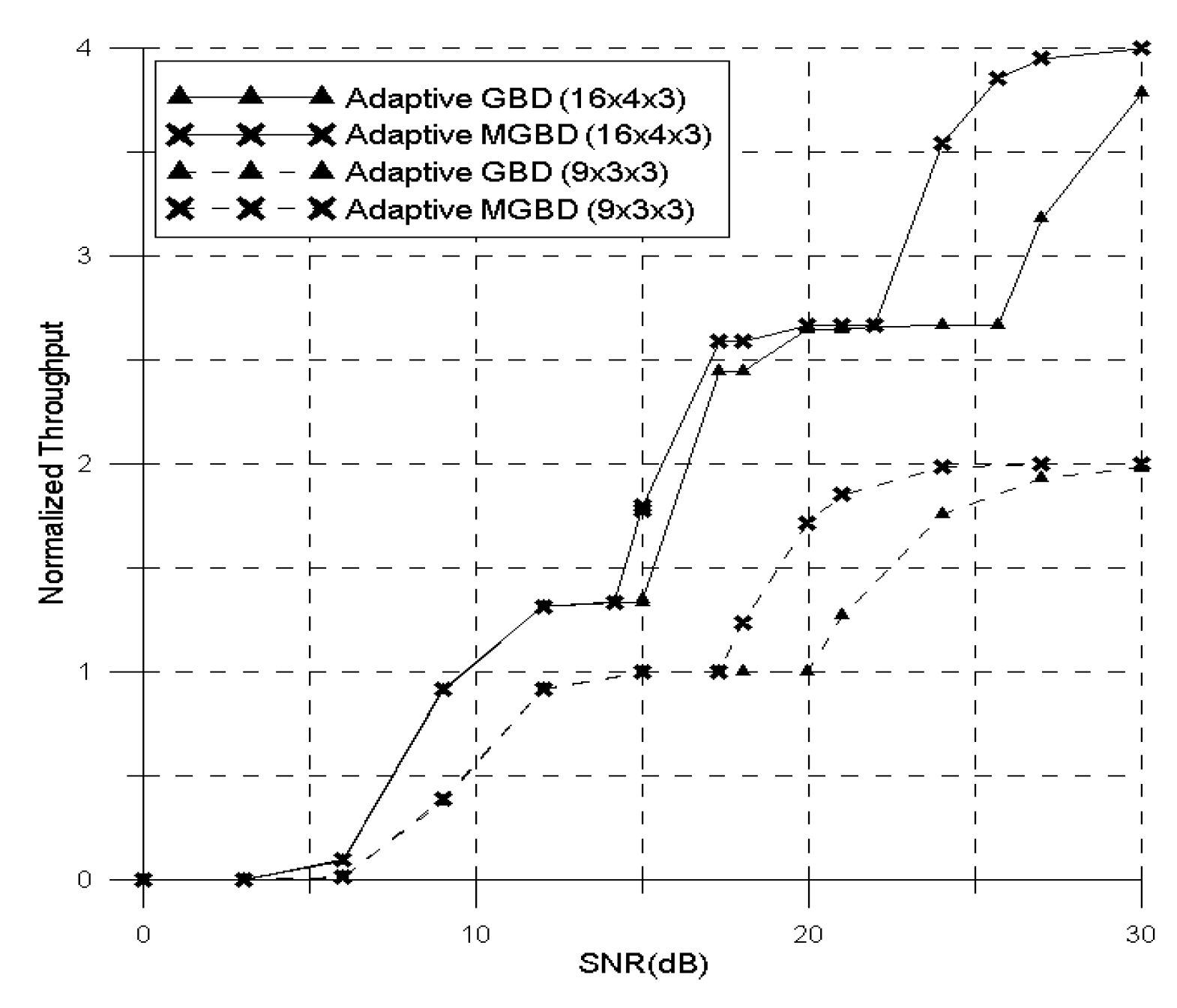
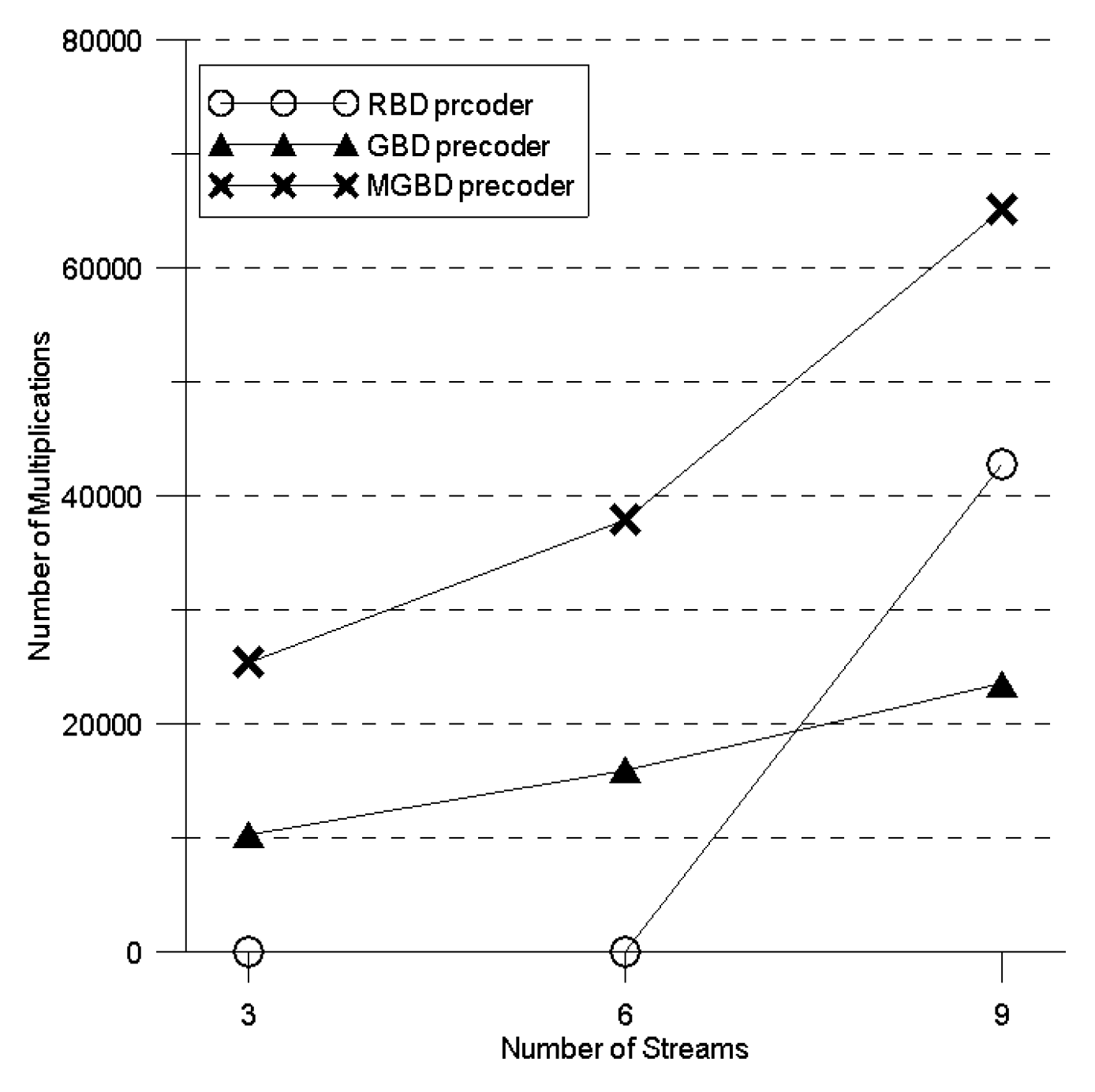
| Parameters | Values |
|---|---|
| Number of simulation iterations | 100,000 |
| Data size | 512 |
| Number of receive antennas | 3 |
| Number of transmit antennas | 16, 9 |
| Number of UEs | 4, 3 |
| Channel | Complex Rayleigh flat fading |
| Modulation order | 16-quadrature amplitude |
| modulation (QAM) | |
| Decoder | Zero forcing (ZF) |
| Operation | Number of Multiplications |
|---|---|
| SVD that only obtains | |
| Full SVD that obtains |
| Operation | Number of Multiplications |
|---|---|
| (Equation (13)) | |
| (Equation (14)) | |
| Total Complexity |
© 2020 by the authors. Licensee MDPI, Basel, Switzerland. This article is an open access article distributed under the terms and conditions of the Creative Commons Attribution (CC BY) license (http://creativecommons.org/licenses/by/4.0/).
Share and Cite
Lee, W.-S.; Ro, J.-H.; You, Y.-H.; Hwang, D.; Song, H.-K. An Enhanced Precoder for Multi User Multiple-Input Multiple-Output Downlink Systems. Appl. Sci. 2020, 10, 4547. https://doi.org/10.3390/app10134547
Lee W-S, Ro J-H, You Y-H, Hwang D, Song H-K. An Enhanced Precoder for Multi User Multiple-Input Multiple-Output Downlink Systems. Applied Sciences. 2020; 10(13):4547. https://doi.org/10.3390/app10134547
Chicago/Turabian StyleLee, Woon-Sang, Jae-Hyun Ro, Young-Hwan You, Duckdong Hwang, and Hyoung-Kyu Song. 2020. "An Enhanced Precoder for Multi User Multiple-Input Multiple-Output Downlink Systems" Applied Sciences 10, no. 13: 4547. https://doi.org/10.3390/app10134547
APA StyleLee, W.-S., Ro, J.-H., You, Y.-H., Hwang, D., & Song, H.-K. (2020). An Enhanced Precoder for Multi User Multiple-Input Multiple-Output Downlink Systems. Applied Sciences, 10(13), 4547. https://doi.org/10.3390/app10134547





